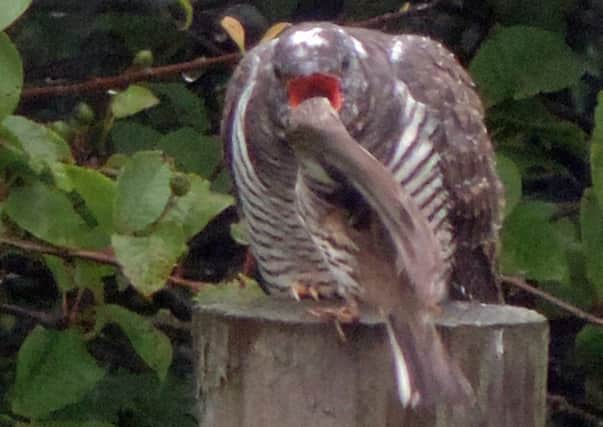Birdwatch: Young cuckoos get set for maiden flights


A female cuckoo in April will wait for an opportunity to sneak in and lay an egg in the nest of a host bird, switching it for one of the host’s eggs which she eats.
She can lay up to 20 eggs in a season and dunnocks, reed warblers and meadow pipits such as this one in Becky Huff’s photograph make up 80 per cent of the hosts. Meadow pipits are the main hosts on moorlands and the photograph was taken in the car park at Scar House reservoir above Pateley Bridge.
Advertisement
Hide AdAdvertisement
Hide AdThe cuckoo’s egg had been inside the female a day longer than most other birds so hatches first in the host nest. It then wastes no time in pushing any other eggs or young out of the nest.
By the time it fledges it dwarfs the host parents and begs constantly for food with its huge gape opened wide. Its beseeching calls not only stimulate them but sometimes other small birds that will queue up to take part in food deliveries.
After fledging the young cuckoo continues to be fed for two-three weeks until it finally strikes out on its own. It then faces its first journey to Africa without any help from experienced adults.
There is better news regarding cuckoos in the British Trust for Ornithology’s latest Breeding Bird Survey which showed a 27 per cent increase in 2014. This is thought to be due to increased rainfall levels in the Sahel just south of the Sahara, an area used by cuckoos and other birds as a stop over before moving further south.
Advertisement
Hide AdAdvertisement
Hide AdBut long-term the trends for cuckoos aren’t so encouraging with a 46 per cent decline in numbers between 1995-2013.
Two juvenile black storks have been seen around the Humber, one at Spurn, Beacon Ponds, and Kilnsea which had rings on both legs prove it has come from northern France. It remained at Spurn the following day. The second stork was at Blacktoft Sands, Alkborough Flats and Read’s Island and was also seen further south in Lincolnshire.
A great white egret was seen with up to 27 little egrets at Blacktoft Sands while a glossy ibis was at Brough Airfield Marsh.
At least 16 wader species have been seen at Blacktoft Sands including a pectoral sandpiper, later seen at Thorne Moors, while a white-rumped sandpiper continues to visit Beacon Ponds and Spurn. Another white-rumped sandpiper was on the beach at South Gare, Cleveland.
Advertisement
Hide AdAdvertisement
Hide AdA Workers Education Association course, Birdwatching for Everyone - Birds of Prey, with Sheila Nash is being held in the Council Chamber at Pateley Bridge. The courses start on September 24 for six sessions: three indoors between 9.30-11.30am and three outdoors going to different venues to birdwatch.The fee is £56. Enrol at wea.org.uk. Email enquiries to [email protected]